Soliton Solutions of the Coupled Schrödinger-Boussinesq Equations for Kerr Law Nonlinearity
Abstract
In this paper, the coupled Schrödinger-Boussinesq equations (SBE) will be solved by the sech, tanh, csch, and the modified simplest equation method (MSEM). We obtain exact solutions of the nonlinear for bright, dark, and singular 1-soliton solution. Kerr law nonlinearity media are studied. Results have proven that modified simple equation method does not produce the soliton solution in general case. Solutions may find practical applications and will be important for the conservation laws for dispersive optical solitons.
1. Introduction
All optical communications are being used for transcontinental and transoceanic data transfer, through long-haul optical fibers, at the present time. There are various aspects of soliton communication that still need to be addressed. One of the features is the dispersive optical solitons. In presence of higher order dispersion terms, soliton communications are sometimes a hindrance as these dispersion terms produce soliton radiation. Nonlinear evolution equations have a major role in various scientific and engineering fields, such as optical fibers. Nonlinear wave phenomena of dispersion, dissipation, diffusion, reaction, and convection are very important in nonlinear wave equations. In recent years, quite a few methods for obtaining explicit traveling and solitary wave solutions of nonlinear evolution equations have been proposed. In recent years, exact homoclinic and heteroclinic solutions were proposed for some NEEs like nonlinear Schrödinger equation, Sine-Gordon equation, Davey-Stewartson equation, Zakharov equation, and Boussinesq equation [1–7].
In particular, the study of the coupled Schrödinger-Boussinesq equations has attracted much attention of mathematicians and physicists [8–10]. The existence of the global solution of the initial boundary problem for the equations was investigated in [8]. The existence of a periodic solution for the equations was considered in [9]. Kilicman and Abazari [10] used the (G′/G)-expansion method to construct periodic and soliton solutions for the Schrödinger-Boussinesq. The investigation of nonlinear partial differential equations plays an important role in the study of nonlinear physical phenomena [9–12].
The nonlinear coupled Schrödinger-Boussinesq equation (SBE) governs the propagation of optical solitons in a dispersive optical fiber and is a very important equation in the area of theoretical and mathematical physics. This paper is going to take a look at the bright, dark, and singular soliton solutions for Kerr law nonlinearity media.
2. Governing Equations
3. The Traveling Solution
4. Hyperbolic Function Methods
The solutions of many nonlinear equations can be expressed in the following form.
4.1. Sech Function Method (Bright Soliton) [21]
4.2. Tanh Function Method (Dark Soliton) [22]
4.3. Csch Function Method (Singular Soliton) [21, 22]
We substitute (6), (7), or (8) into the reduced equation (5), balance the terms of the sech, tanh, and csch functions, and solve the resulting system of algebraic equations by using computerized symbolic packages. We next collect all terms with the same power in sechk(μξ), tanhk(μξ), or cschk(μξ), set to zero their coefficients to get a system of algebraic equations among the unknowns A, μ, and β, and solve the subsequent system.
5. The Application
5.1. Bright Soliton
Figures 1 and 2 represent the solitary wave of the real part of E1(x, t) in (23) and N1(x, t) in (24), respectively, for −5 ≤ x ≤ 5, 0 ≤ t ≤ 1.
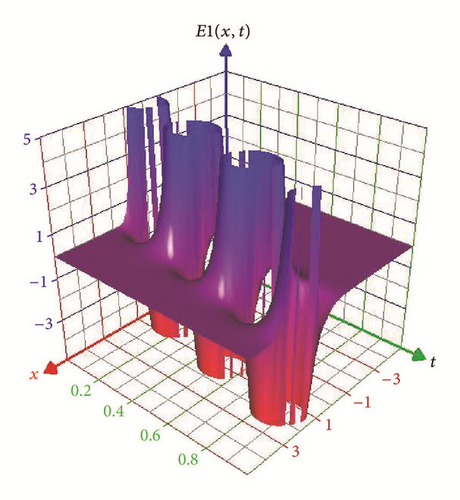

5.2. Dark Soliton
Figures 3 and 4 represent the solitary wave of the real part of E2(x, t) in (32) and N2(x, t) in (33) for −5 ≤ x ≤ 5, 0 ≤ t ≤ 1.
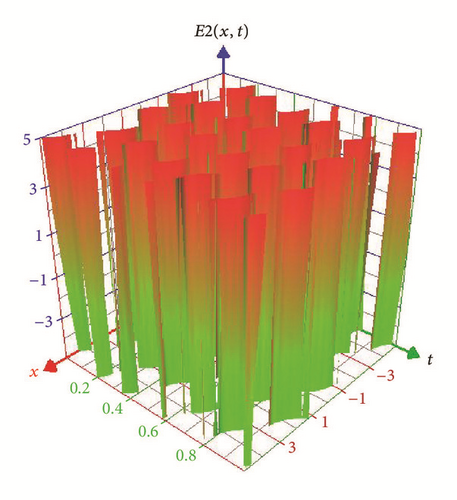
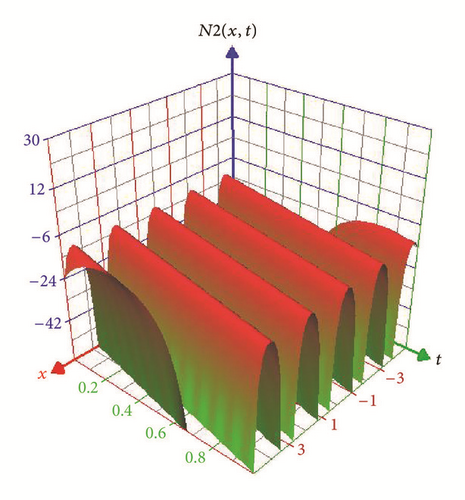
5.3. Singular Soliton
Figures 5 and 6 represent the solitary wave of the real part of E3(x, t) in (40) and N3(x, t) in (41) for −5 ≤ x ≤ 5, 0 ≤ t ≤ 1.
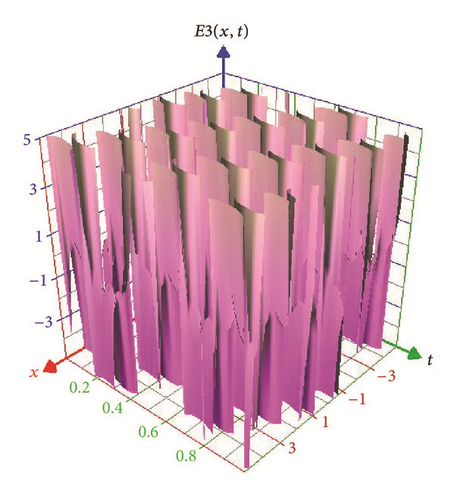
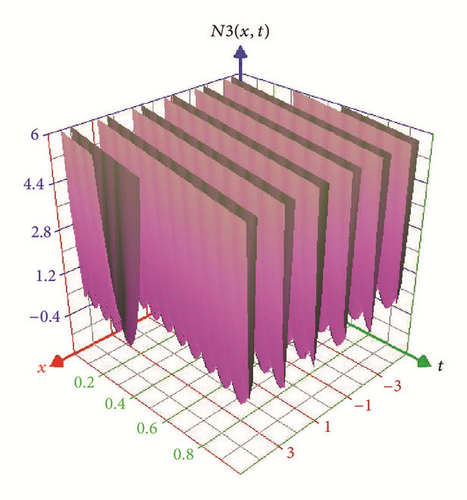
5.4. Modified Simple Equation Method
In (11), we balance u′′ with uv, to obtain m + 2 = m + n, and then n = 2. While in (15), We balance v′′ with u2, to obtain n + 2 = 2m, and then m = 2.
6. Conclusion
In this paper the dispersive bright, dark, and singular soliton solutions to SBE with Kerr law of nonlinearity were studied. The sech, tanh, csch, and the modified simplest equation method have been successfully applied to find solitons solutions for the coupled Schrödinger-Boussinesq equations. Several constraint conditions were assuring the existence of such solitons with Kerr law nonlinearity. The modified simple equation method does not produce the soliton solution in general case. Solutions by three methods are plotted in figures for the real and imaginary parts for E(x, t) and N(x, t). Compatibility in figures shape between the solutions of E(x, t) and N(x, t) by the same method sometimes appeared. Solutions may be important for the conservation laws for dispersive optical solitons. Those research outcomes will be soon disseminated.
Conflicts of Interest
The authors declare that there are no conflicts of interest regarding the publication of this paper.
Acknowledgments
This work was supported by Al-Rafidain University College.




